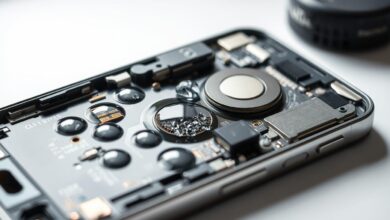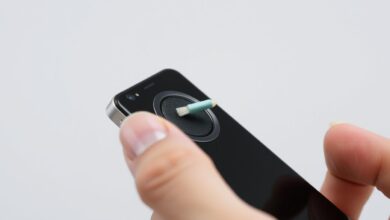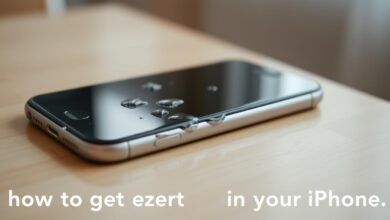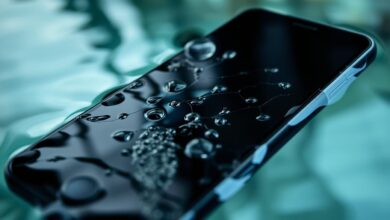how to get water out your phone speaker
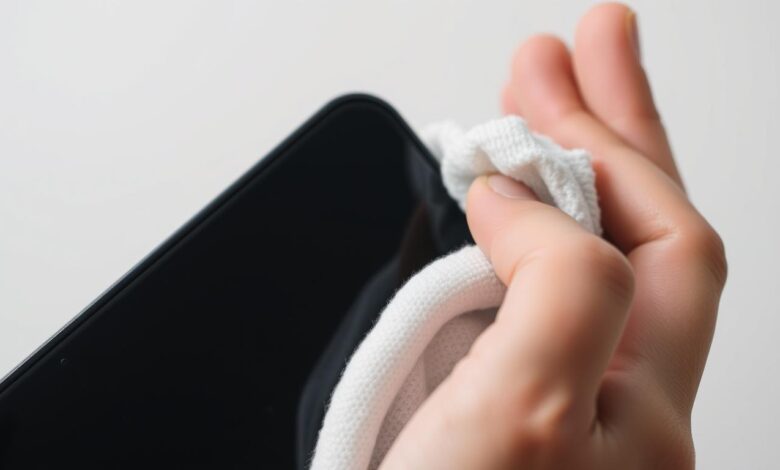
Dropping your phone in water or getting it wet can be really stressful. If water gets into your phone’s speaker, it might make sounds muffled or stop working altogether. In this guide, I’ll show you how to remove moisture from your phone’s speaker.
We’ll look at different ways to dry out your phone’s speaker. This includes using sound frequencies and manual methods. Knowing these steps is key to saving your phone from water damage.
Key Takeaways
- Understand the risks of water damage to your phone speaker.
- Learn effective methods to remove water from your phone speaker.
- Discover preventive measures to avoid future water damage.
- Explore the use of sound frequencies to dry out your phone speaker.
- Manual techniques to dry your phone speaker will be covered.
Understanding Water Damage in Phone Speakers
Knowing how water affects your phone’s speaker is key to fixing damage. Water can seriously harm your phone, especially the speaker.
How Water Affects Speaker Components
Water in the speaker can cause corrosion, harm the diaphragm, or mess with electrical connections. This can lead to bad sound or a broken speaker.
Types of Water Damage
There are different kinds of water damage, including:
- Freshwater exposure, which can still cause a lot of damage because it conducts electricity.
- Saltwater exposure, which is very harmful because it corrodes things.
- Exposure to other liquids, like soda, coffee, or juice, which can leave behind residues that mess with sound quality.
Risks of Ignoring Water in Speakers
Ignoring water in your phone speaker can cause permanent damage. This can lead to poor sound or a broken speaker. You need to act fast to avoid these problems.
Ignoring water damage can lead to corrosion, diaphragm damage, and electrical issues. It’s crucial to fix water damage quickly to avoid these problems.
Quick Assessment: How Serious Is Your Situation?
To fix water stuck in your phone speaker, first figure out how bad it is. If your phone gets wet, you should check the damage fast. This helps you choose the right fix.
Signs Your Phone Speaker Has Water Damage
Look out for distorted sound, muffled audio, or no sound at all. You might also hear crackling or buzzing from the speaker.
Determining the Extent of Water Exposure
Water exposure can range from a few drops to full submersion. Knowing how your phone got wet helps you figure out the best fix. For example, if it was fully submerged, the damage is likely worse than a splash.
| Signs of Water Damage | Possible Extent of Damage |
|---|---|
| Distorted sound or no sound | Speaker component damage |
| Crackling or buzzing noises | Water still present in speaker |
| Phone not turning on | More extensive damage, possibly beyond speaker |
When to Seek Professional Help vs. DIY Solutions
If you’re not sure about the damage or if your phone won’t turn on, get professional help. For minor issues, you can try DIY fixes to remove water from your phone speaker.
Quickly assessing your situation and knowing the signs of water damage helps you fix your phone’s speaker.
Immediate Actions to Take When Your Phone Gets Wet
When your phone gets wet, you must act fast. Quick and correct actions can help fix your wet phone speaker and get your phone working again.
Power Off Your Device Immediately
First, turn off your phone right away. This stops short circuits that could harm it more. Water and electricity together can cause big problems.
Remove Case and External Accessories
Then, take off any cases and accessories. This makes it easier to drain water from the phone speaker. It also lowers the chance of water getting stuck and causing more harm.
Wipe External Moisture
Use a soft cloth to wipe your phone’s outside. This removes any water you can see. But be gentle to avoid pushing water into the phone.
Positioning Your Phone for Optimal Drainage
Place your phone so water can drain out. For example, hold it so the speaker holes are down. This helps water flow out better.
| Action | Purpose | Benefit |
|---|---|---|
| Power Off Device | Prevent short circuits | Reduces risk of further damage |
| Remove Case and Accessories | Facilitate water drainage | Enhances drying process |
| Wipe External Moisture | Remove visible water | Reduces risk of additional damage |
| Position for Drainage | Aid in water escape | Helps in draining water from speaker |
By taking these quick steps, you can greatly improve your phone’s chances of being fixed. Fast and right action is crucial to reduce water damage and get your phone working again.
How to Get Water Out Your Phone Speaker Using Sound Frequencies
Using sound frequencies is a clever way to remove water from your phone speaker. It’s a non-invasive method that’s gaining popularity. It’s seen as effective and easy to use.
The Science Behind Sound Wave Water Removal
Sound wave water removal works by using sound frequencies to dislodge water. When a specific sound is played, it creates vibrations. These vibrations can push water out of the speaker’s crevices.
This method depends on the speaker’s ability to produce sound waves at a precise frequency. Frequencies between 165 Hz and 200 Hz are believed to be the most effective for removing water.
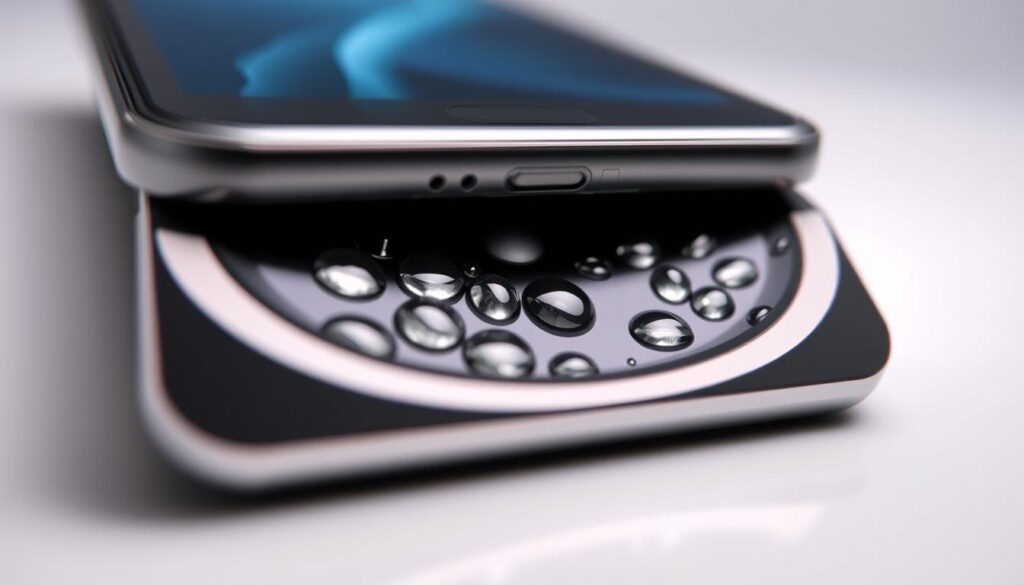
Using Water Eject Apps and Websites
There are apps and websites that help remove water from phone speakers using sound frequencies. These tools are easy to use and work on both Android and iOS devices.
Top Apps for Android Devices
- Sound Frequency: An app that generates a range of sound frequencies, including those used for water ejection.
- Water Eject: Specifically designed to remove water from phone speakers using sound waves.
Top Apps for iOS Devices
- Sound Test: Allows users to play various sound frequencies, including those effective for water removal.
- Water Out: An app tailored for iOS devices to help eject water from speakers.
Step-by-Step Guide to Using Sound Frequencies
- Download a Water Eject App: Choose an appropriate app based on your device’s operating system.
- Play the Sound Frequency: Open the app and play the recommended frequency for water ejection.
- Position Your Phone: Place your phone on a flat surface to allow gravity to assist in water removal.
- Monitor the Process: Observe as water is ejected from the speaker. You may need to repeat the process several times.
By following these steps and using the right tools, you can effectively remove water from your phone speaker using sound frequencies. This method is a convenient and often successful way to address water damage without causing further harm to your device.
Using Built-in Water Ejection Features
Smartphone makers have come up with cool built-in tools to help get water out of phone speakers. These tools can really help you get your device working again.
Many big brands have created special tools to handle water problems. Let’s take a look at some of these tools.
Apple’s Water Eject Feature for iPhones
Apple has added a water ejection feature to iPhones. You can find it in the Shortcuts app. It uses sound waves to push water out of the speaker grills. To use it, make a shortcut that plays a special sound to get rid of water.
Samsung’s Water Lock Mode
Samsung phones have a Water Lock Mode. It stops more water from getting in and helps get rid of water already inside. You can find it in your phone’s settings. It works with the phone’s hardware to push water out of the speakers.
Other Manufacturers’ Water Removal Tools
Other phone makers, like Google and OnePlus, also have tools to help with water damage. Some phones have special sound settings or tools to help remove water. Check your phone’s manual or the manufacturer’s website for how to use them.
Even with these built-in tools, sometimes you need to dry your device by hand. It’s important to know their limits.
Using these built-in tools can help you fix water in your phone speaker. But, how well they work depends on how much water got in and what phone you have.
Manual Methods to Remove Water from Phone Speakers
Getting water out of your phone’s speaker can be tough. But, there are manual ways that work. If sound frequencies and built-in features don’t help, try these other methods.
The Gravity Method: Proper Positioning Techniques
Gravity can help remove water from your phone’s speaker. Hold your phone in a way that lets gravity pull the water out. For example, if water is in the speaker, hold your phone with the speaker down. This makes it easier for water to drip out.
Gentle Tapping Technique
Gently tapping your phone can also work. Turn off your phone and tap it softly on a soft surface with the speaker down. Don’t tap too hard to avoid damaging your phone’s inside.
Using Compressed Air Safely
Compressed air can also remove water, but be careful. Hold the can upright and spray air in short bursts from a safe distance. Don’t spray too close to your phone to avoid damage.
What NOT to Do When Removing Water
It’s also important to know what not to do. Don’t use heat like hair dryers, as they can harm your phone. Also, don’t put things like cotton swabs or paper towels in the speaker. They can push debris in or damage the speaker.
| Method | Description | Safety Precaution |
|---|---|---|
| Gravity Method | Position phone to let gravity pull water out | Ensure phone is turned off |
| Gentle Tapping | Gently tap phone on a soft surface | Avoid tapping too hard |
| Compressed Air | Use compressed air in short bursts | Hold can upright and spray from a distance |
By using these manual methods carefully, you can try to get water out of your phone’s speaker. But, if it still doesn’t work, you might need professional help.
“The key to resolving water damage issues often lies in acting quickly and using the right techniques. Patience and caution are crucial when attempting to remove water from phone speakers.”
Drying Agents and Absorbent Materials
Choosing the right materials is key when drying your phone speaker. Water damage can be a real hassle. But, the right drying agents and absorbent materials can help repair your wet phone speaker effectively.
It’s important to know about the different drying agents out there. We’ll look at some common methods and materials to dry your phone speaker.
Silica Gel Packets: How to Use Them Effectively
Silica gel packets are great at soaking up moisture. To use them, put your phone in a container with several packets. Make sure your phone is fully covered. Then, seal the container and wait 24-48 hours. This method is especially good for drying a waterlogged phone speaker.
Uncooked Rice: Myth vs. Reality
Many people use uncooked rice to dry a wet phone. But, its effectiveness is up for debate. Rice can absorb moisture, but it’s not the best choice because it doesn’t touch the phone’s parts well.
Commercial Drying Products for Electronics
There are special products made just for drying electronics. These products work better than household items like rice. They come in forms like desiccant packets or drying cases for your phone.
DIY Drying Solutions
If you’re looking for something different, DIY solutions can work. For example, you can make a drying chamber with a plastic container and silica gel. This setup helps control the drying environment for your phone.
| Drying Method | Effectiveness | Ease of Use |
|---|---|---|
| Silica Gel Packets | High | Easy |
| Uncooked Rice | Moderate | Easy |
| Commercial Drying Products | High | Easy to Moderate |
| DIY Drying Solutions | Variable | Moderate to Difficult |
In conclusion, picking the right drying agents and materials is key to repairing a wet phone speaker. Knowing your options helps you choose the best way to dry your phone. This might save it from water damage.
Advanced Techniques for Stubborn Water Removal
When simple methods don’t work, it’s time to try more advanced techniques. These methods are great for water that’s deeply inside the speaker. They’re also good when other drying methods don’t work.
Using a Vacuum Cleaner Safely
A vacuum can gently remove water from your phone speaker. Make sure to use it on a low setting to avoid damage. Set the vacuum to a gentle suction mode to avoid pushing debris further into the speaker. Hold the nozzle a few inches away to control the suction.
Isopropyl Alcohol Method
The isopropyl alcohol method uses alcohol to help remove water. Isopropyl alcohol has a lower surface tension than water, making it easier to remove water from the speaker’s crevices. Carefully drop a small amount of isopropyl alcohol into the speaker. Then, use a sound frequency app to help expel the liquid.
Ultrasonic Cleaning (Professional Option)
For severe water damage, ultrasonic cleaning by a professional is a good option. This method uses sound waves to create a cleaning solution that can reach deep into the speaker. It’s essential to have this done by a professional to avoid damaging the phone’s internal components.
| Method | Effectiveness | Risk Level |
|---|---|---|
| Vacuum Cleaner | Moderate | Low |
| Isopropyl Alcohol | High | Moderate |
| Ultrasonic Cleaning | Very High | High |
Trying these advanced techniques can help remove stubborn water from your phone speaker. Always be careful and consider professional help if you’re not sure what to do.
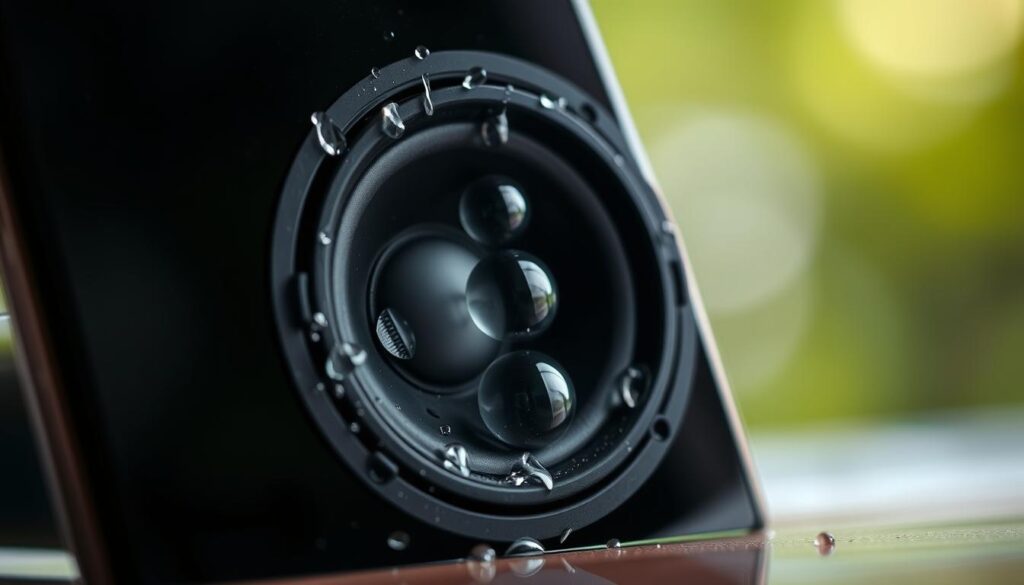
Dealing with Different Types of Liquid Damage
When your phone gets wet, the type of liquid matters a lot. Not all liquids are the same. Knowing the difference helps fix the problem better.
Freshwater vs. Saltwater Exposure
Freshwater and saltwater affect your phone’s speaker differently. Freshwater is less harmful. Saltwater, being more conductive, can cause short circuits. If your phone meets saltwater, act fast to lessen damage.
Key differences between freshwater and saltwater damage:
- Freshwater is less corrosive and may cause less immediate damage.
- Saltwater is more conductive and can cause short circuits.
- Saltwater damage often requires more thorough cleaning to remove corrosive salt residues.
Removing Sticky Liquids (Soda, Coffee, Juice)
Sticky liquids like soda, coffee, or juice are hard to deal with. They can clog your phone’s speaker. You need to act fast and use the right methods.
Steps to remove sticky liquids:
- Immediately power off your phone to prevent any short circuits.
- Gently wipe the exterior with a soft cloth to remove any excess liquid.
- Use a sound frequency app or website to help eject the liquid from the speaker.
Handling Chemical Liquid Exposure
Chemical liquids, like those in cleaning products, can be very corrosive. They can harm your phone’s internal parts. Handling chemical exposure needs extra care.
Precautions for chemical liquid exposure:
- Avoid touching any components that may have come into contact with the chemical.
- Rinse the affected area with distilled water, if appropriate, to dilute the chemical.
- Seek professional help immediately, as chemical damage can be severe and require specialized cleaning.
In conclusion, dealing with different types of liquid damage needs a specific approach. By understanding the challenges each liquid poses, you can take the right steps. This might save your phone’s speaker.
Testing Your Speaker After Water Removal
The last step in fixing your phone speaker after water damage is to test it. It’s important to make sure it works right before you think it’s fixed.
Safe Ways to Test Speaker Functionality
To safely test your speaker, play some music or a video with clear sound. Start with low volumes to avoid more damage if it’s not working. Then, slowly turn up the volume to check for any problems. You can also use your phone’s built-in test features or download a special app.
- Play music or videos to test audio quality
- Start with low volumes and gradually increase
- Use built-in or third-party speaker test apps
Common Post-Water Damage Issues
Speakers can have issues after water damage, like muffled sound or crackling. Water can also cause corrosion, leading to these problems. Sometimes, the speaker might work sometimes or sound distorted.
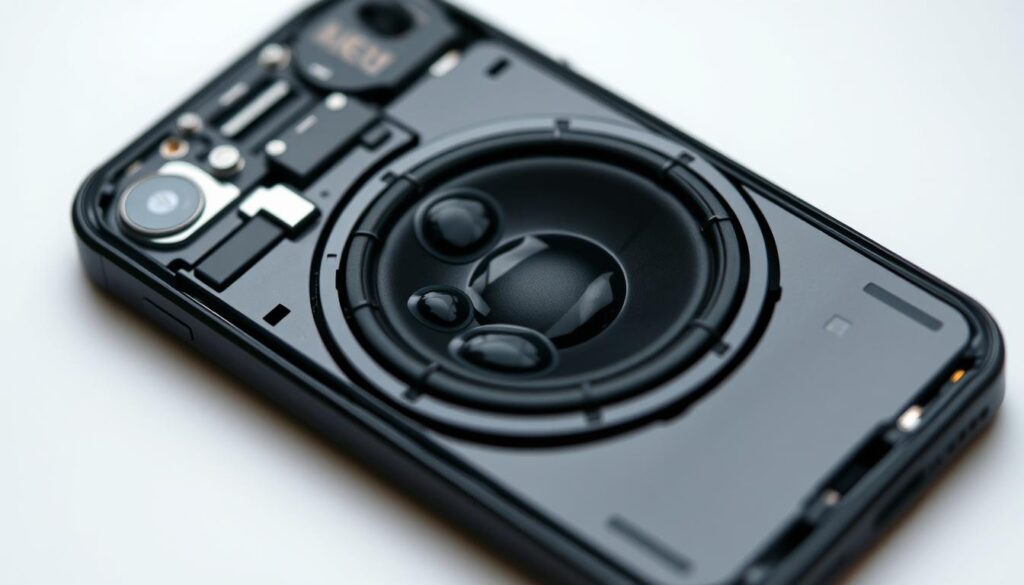
When to Wait Before Testing
Wait until you’re sure the speaker is dry before testing. Testing a wet speaker can damage it more, like short circuits. Let it dry completely, and use drying agents or methods from before to speed it up.
- Ensure the speaker is completely dry
- Avoid testing if you suspect remaining moisture
- Use drying methods to speed up the drying process
By following these steps and being patient, you can test your phone speaker after water removal. This will help you know if you need to fix it more.
Preventing Future Water Damage to Your Phone
It’s crucial to prevent water damage to your phone. Water damage can be very harmful, leading to expensive repairs or making your phone unusable. By taking steps ahead of time, you can lower the chance of water damage to your phone’s speaker and other parts.
Waterproof Cases and Covers
Using a waterproof case or cover is a great way to protect your phone from water. These items act as a shield, keeping your device safe from water splashes or full submersion. When picking a waterproof case, make sure it has a high IP rating, showing its water resistance level.
Water-Resistant Phone Models
Some phones are made to be more water-resistant, with built-in protections like seals around ports and speakers. If you’re looking for a new phone, choose models with high water resistance ratings. These phones can handle water better than others.
Best Practices for Using Phones Near Water
Even with water-resistant phones or cases, be careful when using your device near water. Don’t use your phone in heavy rain, near swimming pools, or during water activities. If you must use your phone near water, make sure it’s well-protected and stay alert to your surroundings.
Understanding IP Ratings for Water Resistance
IP ratings show how well a device can handle solids and liquids. The rating is two digits, with the first digit for solid protection and the second for liquid. For example, an IP67 rating means the device is dustproof and can handle being underwater up to 1 meter for 30 minutes. Knowing IP ratings helps you choose the right phone accessories or devices.
By following these preventive steps, you can use your phone near water or in wet conditions without worry. This reduces the risk of water damage to your phone’s speaker and other important parts.
When DIY Methods Fail: Professional Repair Options
If your phone’s speaker still doesn’t work after trying DIY fixes, it’s time to look at professional help. Some water damage needs special skills and tools that DIY can’t provide.
Manufacturer Warranty and Water Damage Policies
Before you go for third-party repairs, know your phone’s warranty and water damage policy. Brands like Apple and Samsung have rules about water damage that might not be covered by the warranty. Checking your warranty status helps figure out what to do next and how much it might cost.
Finding Reputable Repair Services
To fix water in phone speaker right, you need a trusted repair service. Look for ones with experience in water damage fixes and good reviews. Authorized centers are best because they use real parts and follow manufacturer guidelines.
Expected Costs for Professional Speaker Repair
The price for fixing a speaker varies a lot. It depends on your phone, how bad the damage is, and who you choose to fix it. Usually, it costs between $50 and $200. Always ask for a price quote before you decide.
Insurance Coverage for Water Damage
See if your phone insurance covers water damage. Some policies, from big carriers or other insurers, might cover accidents, including water damage. Knowing what your insurance covers can help lower the cost of repairs.
In short, if DIY fixes don’t work, you need professional help. By understanding warranties, finding reliable services, knowing the costs, and using insurance, you can choose the best way to fix your phone’s speaker.
Conclusion
Removing water from your phone speaker is urgent and needs the right steps. This guide shows how to dry your phone speaker and avoid more harm. You can use sound frequencies, manual methods, or a mix of them.
It’s key to test your speaker after trying to dry it out. This ensures it works right and keeps it safe from water damage in the future.
To get water out of your phone speaker, try sound frequencies or manual methods. Quick action and patience are crucial. If problems persist, getting professional help might be necessary.
Knowing how to remove water from your phone speaker can save you from costly repairs or even buying a new one.
Preventing water damage to your phone speaker is possible with the right precautions. Clean your phone often, use a waterproof case, and be careful near water. This guide has given you the tools to handle water damage and keep your phone’s speaker working well.
FAQ
How do I know if my phone speaker has water damage?
Look out for distorted sound, no sound at all, or crackling noises. These are signs of water damage.
Can I use a hair dryer to dry out my phone speaker?
No, using a hair dryer is not a good idea. It can push water deeper into your phone or damage it with too much heat.
What is the best method to remove water from my phone speaker?
Sound frequencies through apps or websites are a popular choice. You can also try the gravity method or gentle tapping.
How do I use sound frequencies to remove water from my phone speaker?
Download a water eject app or visit a website that generates sound frequencies. Follow the app’s or website’s instructions to play the sound.
Can I use uncooked rice to dry out my phone?
Using uncooked rice is debated. Silica gel packets or commercial drying products are usually more reliable for drying your phone.
What should I do immediately after my phone gets wet?
First, power off your device. Then, remove the case and external accessories. Gently wipe external moisture and position your phone for optimal drainage.
How can I prevent future water damage to my phone speaker?
Use a waterproof case or cover. Choose a water-resistant phone model. Follow best practices for using your phone near water. Understand your phone’s IP rating for water resistance.
What if DIY methods fail to remove water from my phone speaker?
If DIY methods don’t work, consider professional repair services. Check your manufacturer’s warranty and water damage policies. Explore insurance coverage options.
How can I test my phone speaker after attempting to remove water?
Play music or a video with clear audio to test your speaker. Check for distorted sound or any abnormalities. If issues persist, consider professional repair.
Is it safe to use compressed air to remove water from my phone speaker?
Compressed air can be used, but with caution. Avoid pushing the can too hard, which can force water further into your phone. Use short, gentle bursts.
Can saltwater damage my phone speaker more than freshwater?
Yes, saltwater is more corrosive than freshwater and can cause more severe damage to your phone speaker. Prompt action is crucial in such cases.
What are the risks of ignoring water in my phone speaker?
Ignoring water in your phone speaker can lead to permanent damage. This can result in poor sound quality or complete speaker failure.
